Foreign Investment Flows into U.S. Treasuries and Money Printing Consequences
Interest-Rates / US Bonds Jul 29, 2009 - 02:07 AM GMTBy: Michael_Pollaro
 Obama and Company say... All We Need Is A Little Help From Our Foreign Friends
Obama and Company say... All We Need Is A Little Help From Our Foreign Friends
Oh I get by with a little help from my friends
Mm going to try with a little help from my friends
Oh I get high with a little help from my friends
Yes I get by with a little help from my friends
With a little help from my friends
Refrain to The Beatles “With a Little Help from My Friends”
Are Obama, Geithner and Clinton, Bernanke too, Beatle fans? If not, they should be. It’s quite possible they have been singing some version of this Beatle song to many a foreign creditor of late, asking for a little more help, just a bit more time to put the US economy and its fiscal finances in proper working order.
Hey, if they don’t like the US fiscal position, maybe they like The Beatles!
No, this is not an essay about my beloved Beatles. This is an essay about the importance of foreign creditors to the US government’s fiscal exploits. Indeed, to say that foreign creditors are important to the US government is a gross understatement.
At the end of its 2008 fiscal year, ending in September, the government reported that foreign creditors held 48% of US public debt. In dollar terms, that was $2.8 trillion in IOU’s. What’s more, they absorbed 74% of the $765 billion borrowed by the US government in 2008. But that’s nothing new. Foreign creditors have been on a buying extravaganza since 2002, sucking up 73% of public debt net new issuance over that period, a whopping $1.8 trillion of government IOU’s.
Obama and company are thankful for the helping hand, as they invite their foreign friends back for more. US public borrowing needs for fiscal 2009 are tracking to an unprecedented $1.8 trillion. That’s 2.4 times the monies borrowed in 2008. At 13% of first quarter 2009 annualized GDP and 250% of first quarter net private savings, excluding the War years 1942 – 1946, it dwarfs anything seen in our lifetime. And fiscal 2010 and beyond, not looking much better. Even without national health care and a sure-to-come stimulus package, many experts are projecting multi-trillion dollar government deficits for years to come. According to the GAO, total government obligations, including the unfunded liabilities of the social insurance trust funds, were $62 trillion at fiscal year end 2008 and growing at $4-5 trillion a year (and that does NOT include many trillions in contingent liabilities the government has assumed in its unending string of bailouts). Unfortunately, US GDP, and more importantly private savings is growing at nothing close to that rate.
This I submit is an economic disaster for America, not only because there is not enough domestic savings to fund the government’s ballooning borrowing needs, but because all that government borrowing “crowds out” private capital investment, and so retards economic growth. No economic growth, no income growth. No income growth, no savings. No savings, no way to fund those government deficits without the continued help of our overseas friends.
This of course is not the story being told by Obama and company. No no. All this government spending, say the Obama team, is going to stimulate the economy and lay the foundation for real economic growth, so America can reduce those government deficits and fund its growth, on its own, without the help of its foreign friends. I say, it’s kind of hard to produce economic growth, to become self sustaining and reduce America’s dependence on foreign creditors, when you take from the productive private sector and give it to the unproductive public sector, when you cannibalize private capital investment in favor of massive government consumption programs.
I know I’m not the only one that doesn’t buy the Obama story? In fact, there may be growing evidence, through their words and actions, that some of America’s foreign creditors may not be buying this story either. And the ones that are buying it, I suspect, are doing so with a great deal of apprehension. That’s not good. Never has America been more dependent on foreign creditors. And as James Grant opined in his July 24th Interest Rate Observer, never have these same foreign creditors been more “restive” about America’s ability to pay them back.
I’m sure you heard this before. The US government debt burden is not just America’s problem; it’s a foreign problem too. Those foreigners got to keep buying those treasuries to protect their investment, right? Maybe so, as long as you’re not the last one buying.
Just what concerns US foreign creditors? In short, default by the US government on its IOU’s, whether that be via an outright default or via a stealth default, through the Federal Reserve’s printing press. As Steve Saville, proprietor of The Speculative Investor suggests, it’s likely a bit of both:
Under the current monetary system there is no limit to how much debt a government can take on, provided that the debt is denominated in its own currency. The reason is that the central bank stands ready, willing and able to be the bond-buyer of last resort, and the central bank's pockets are infinitely deep (there is no limit to the amount of new money that the central bank can create). As a result, if it chose to do so the government could continue to issue new bonds until the currency became worthless. At the point where the currency had lost almost all of its purchasing power the surreptitious default would essentially be complete because any debt denominated in this currency would be almost worthless.
But rather than continue the debt issuance and the associated monetary inflation to the point where the currency is worthless it could, at some stage during the process, become politically more feasible to default directly on a large chunk of the outstanding debt. The reason is that hyperinflation would destroy the economy as well as the currency, and would thus inflict large losses on almost everyone, whereas directly defaulting on the debt would only inflict large losses on the holders of government debt. In the US case it is not hard to envisage the Administration being faced in the future with the following choice: default on all Treasury debt except for the debt held by US government trust funds, or plunge into hyperinflation and wipe out the values of all bonds and all monetary savings. Given that the bulk of the aforementioned Treasury debt is held by foreign governments, a direct default will potentially be the natural choice of the politically astute.
The way things are going it will probably take less than three years for the US and many other countries to reach the point where it becomes necessary to completely abandon the pretense that the government's debt will ever be repaid legitimately (without inflating the currency into oblivion, that is). It will then be a matter of deciding on the method of default.
You don’t want to be a foreign creditor, indeed any creditor to the US government if Steve is even half right!
So any evidence of “restiveness” on the part of Obama and company’s friends? Let’s have a look.
First, the big picture. According to US Treasury TIC data, from a mere 15% in the 1980s, foreign creditors currently hold about 47% of the US public debt, with notable buying surges commencing in 1995, 2002 and again in 2007:
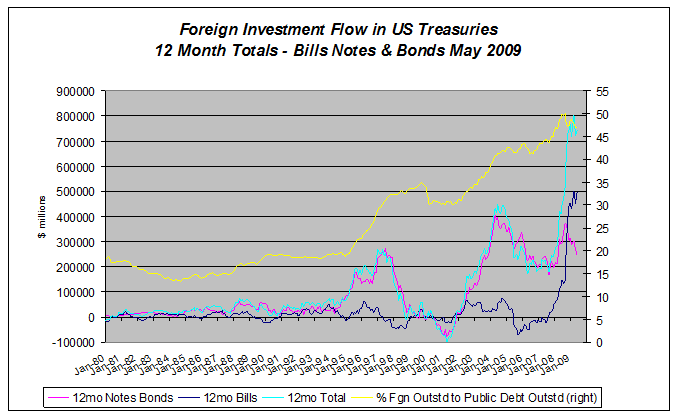
Those foreign creditors just love US government IOUs!
So what’s the problem? Let’s zoom in on the more recent experience:
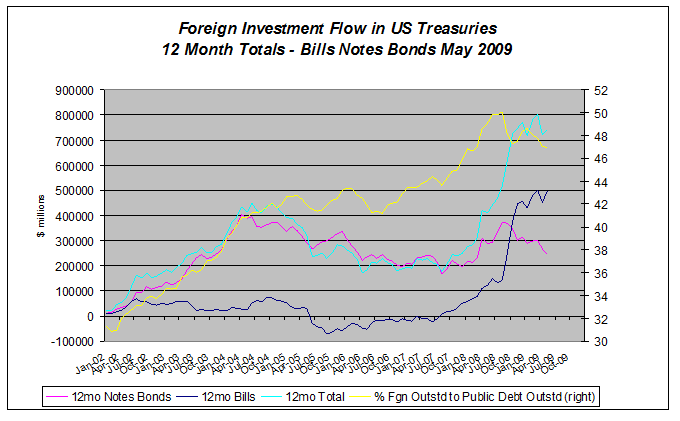
First, observe the recent decline in the percent of public debt held by foreign creditors. After peeking at 50.1% in August 2008, the foreign take of US public debt has fallen by 3.2 percentage points to 46.9%. Over that period, foreign creditors absorbed just 36% of US public debt new issuance, a far cry from the 74% absorbed in 2008 or the 73% absorbed since 2002. This poor result, despite the mad rush into US dollars, and by extension US treasury bills, in the 4th quarter of 2008.
Is US public debt new issuance getting too big, even for Obama and company’s overseas friends? Was August 2008 the top? Maybe so. Have a close look at this chart:
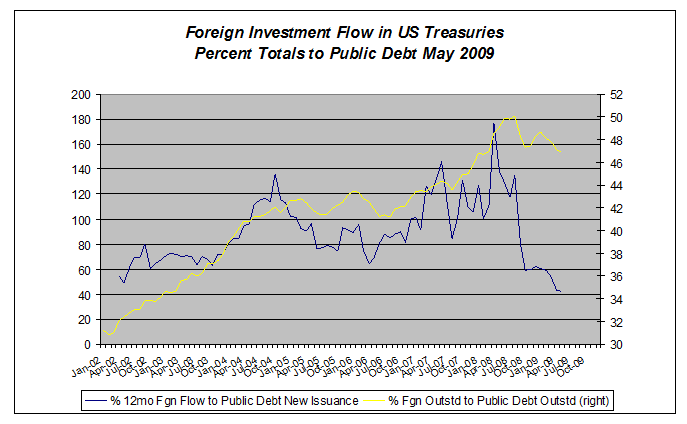
Note the blue line. Quite a drop in the amount of US public debt foreigners have been willing to take of late, at least as a percent of US public borrowing needs, don’t you think?
Returning to the previous chart, note also the possibility of a top in the dollar take of US public debt by foreign creditors. Focus on the precipitous decline in longer-dated notes and bonds, a good gauge of the long-term appetite for US government debt. 12-month foreign investment flow totals show a decline of 34% since August 2008, from $373 billion to $245 billion. Foreigners have been moving away from longer-dated notes and bonds in both absolute dollar terms and as a percent of total investment flows. That’s what fixed income investors do when they are concerned about the kind of default Steve Saville wrote about, especially when long term interest rates are scraping multi-decade lows; they stay short and shun longer-dated maturities.
Is all this evidence of foreign creditor “restiveness”? I think so.
So who’s in and who’s wavering. In other words, how many “friends” do Obama and company really have?
Let’s start with who those creditors are. For those who follow this space, I’m sure you already know the story:
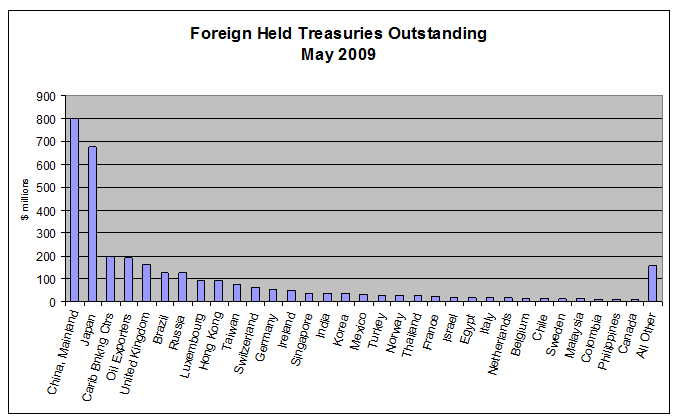
China, and the rest of the BRICs, plus the oil producing countries are at the head of the list, the big buyers this decade. Japan, the old standby, is locked solidly in the number two slot.
What you may not know though is what foreigners have been doing since the August 2008 top:
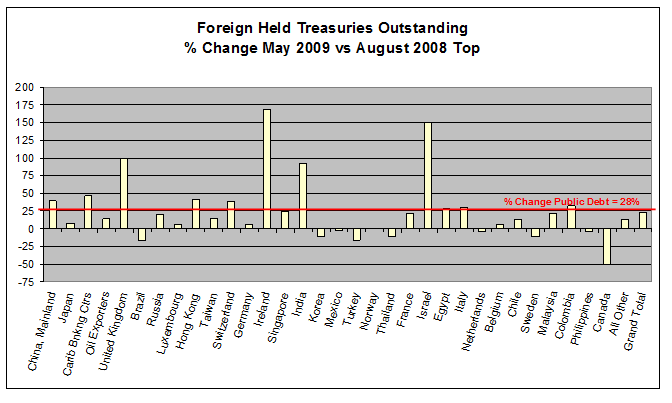
Clearly, not everyone is in the same boat. Not everyone is buying US debt, nor is everyone pulling their weight. Then again, a 28% surge in public debt outstanding in just 9 months is asking quite a lot, even of a friend. Yes, some of the bigger names, like China and the United Kingdom (likely the oil producing nations of the Middle East) are standing tall, but I see cracks at the margin.
Perhaps a scorecard will better illuminate the point:
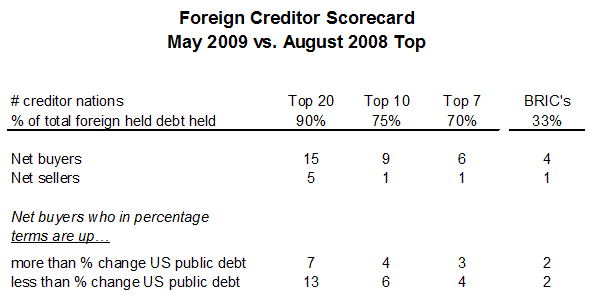
Are the smaller buyers leaving it up to the bigger buyers? Get out before anyone notices? Could be. That can’t make the big buyers of US debt happy. Perhaps that’s one reason why Japan, despite all pronouncements to the contrary, is NOT pulling its weight. The second largest holder of US treasuries shows a mere 7.4 % increase in its holdings since August. And the all important BRICs, are they still in the game? India and China, yes. But Russia is clearly dragging its feet, and Brazil is currently a net seller.
If we all hold hands, if we all buy together, say US government apologists, then we all win, or at least we won’t lose. That’s the underlying assumption here, isn’t it? But given the increasing risks, maybe some countries no longer buy this argument. Maybe the countries with the least to lose or the most amount of alternatives are looking to sell, while the countries with the most to lose or the least amount of alternatives are “forced” to buy more. If true, this is clearly an unsustainable path.
Now, none of this necessarily says that foreign creditors are abandoning Obama and company in their greatest time of need. America’s largest foreign creditors are certainly pulling for the Obama team, giving them the benefit of the doubt, at least for now. For many, their Keynesian economic training tells them to believe. Clearly, they want Bernanke’s unprecedented monetary barrage and zero interest rate policy and Obama’s massive fiscal stimulus to work, to cleanse America’s financial system and restore American growth, so they can get their money back.
As an Austrian economist, I know their policies will fail and that means no one is getting their money back at anywhere near it’s current worth. Economic growth and financial independence are not achieved by borrowing and spending, by printing money out of thin air and by growing the size of government at the expense of the private sector, especially after the biggest economic bust since the Great Depression. All this may give America a temporary respite but it is no cure for what ails the country. Indeed, all this guarantees another, even bigger bust.
Simply said, if Obama and company continue down this path, there will be no real sustainable growth for America. In fact, just the opposite. And that means at least one of Steve Saville’s fears will come true. For as foreign buyers of US government debt begin to sell, or simply stop buying, to cut their loses, I’m afraid that leaves Ben Bernanke’s Federal Reserve as buyer of LAST resort. And when that’s evident to all US government investors, foreign or domestic, it may not be long before Ben’s Federal Reserve becomes the buyer of ONLY resort.
Default via the printing press.
I will have more to say on Ben Bernanke and the Federal Reserve, and what they are up to, in a future essay. Suffice it to say now that Ben has already begun to fill the gaps.
By Michael Pollaro
Email: jmpollaro@optonline.net
I am a retired Investment Banking professional, must recently Chief Operating Officer for the Bank's Equity Trading Division. I am also a passionate free market economist in the Austrian School tradition and private investor
Copyright © 2009 Michael Pollaro - All Rights Reserved
Disclaimer: The above is a matter of opinion provided for general information purposes only and is not intended as investment advice. Information and analysis above are derived from sources and utilising methods believed to be reliable, but we cannot accept responsibility for any losses you may incur as a result of this analysis. Individuals should consult with their personal financial advisors.
Michael Pollaro Archive |
© 2005-2022 http://www.MarketOracle.co.uk - The Market Oracle is a FREE Daily Financial Markets Analysis & Forecasting online publication.



